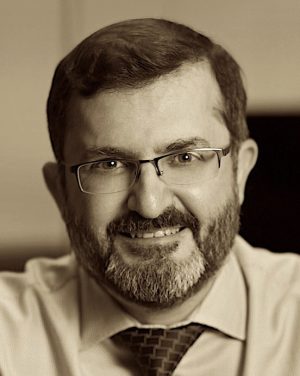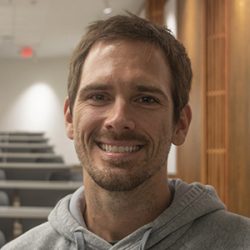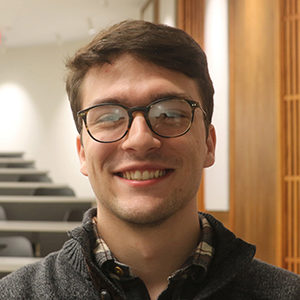 |
| Prof. Joseph H. Saleh |
When Joseph Saleh reads about a downed airplane, an e-scooter crash, or a workplace injury, his mind immediately defaults to a systems analysis that walks him backward through the causal chain: How could that accident have been avoided? What systems failure led to that outcome?
"All engineers should be safety literate," he concludes. "But most engineers and public health professionals receive no cross-training and are generally unfamiliar with their respective skill sets. It's been a loss for both disciplines."
Until now.
In his Accident Causation and System Safety course, Saleh is teaching the next generation of engineers and public health professionals that they must learn from each other. A lot.
"There are so many engineering solutions to injury problems that have public health repercussions. In this class we are teaching our engineering students to anticipate this, to make
safety a part of their routine problem-solving process. And by the same token, there are many public health preventative measures that can be more effective if they incorporate an engineering perspective. Next year, we'll be opening this class up to both engineering and public health students at Emory and Tech."
Assorted Poster Topics |
|
The following is a partial list of the topics that will be presented by 23 teams of students at the Dec. 3 poster presentation. Aerospace Safety
Occupational and Public Health Safety
E-Scooter Safety
Nuclear Safety
|
The Injury Prevention Center at Emory (IPRCE) has recently incorporated Saleh's Accident Causation and System Safety class into the curriculum for its injury prevention certificate program.
The current cohort of Georgia Tech aerospace engineering students enrolled in Saleh's Accident Causation class will present the results of their semester-long safety research at a public poster session on December 3. Their topics range from poultry processing to general aviation, hot-car deaths, and firearm suicide, but their support for Saleh's approach is as seamless as it is uniform.
"This is one of the best classes I've taken at Tech," said Connor Dautel. "It solves one of the biggest hurdles I faced in interviews-- and that's a lack of safety literacy."
 |
| Charles Zander |
Continues his classmate, Charles Zander:
"I spent 10 years [in the Navy] working as a missile tech on the Trident II D5, and a lot of my job was working on high-energy, high-consequence systems in an HRO [high-reliability organization]. The problems we solved were different, but the insight I gained in this class would have been great to have then. It makes so much sense."
Saleh's course takes a multidisciplinary approach to accident causation and system safety. Students pore over accident data from different industries and deconstruct those incidents to identify features common to all systems failures. From there, they are heading that list of shortcomings in the design/technology, the operational and workforce components, and the organizational/ management behavior.
 |
| Connor Dautel |
"Accidents in many different contexts share a conceptual sameness in the way they occur," says Saleh. "What we want to instill in our next generation of engineers is both an understanding of those common elements and a safety culture that will push them to advocate for safety in their future workplaces. We want them to be change agents in any environment where safety is overlooked or compromised."
This goal is as practical as it is lofty for an economy that is increasingly depending on automation to perform critical tasks, Saleh points out. The rise of so-called smart cities -- urban areas that use autonomous unpiloted vehicles for routine human and package transport -- could raise significant safety questions for a safety-illiterate workforce. The rapid automation of many of our current manufacturing processes makes safety issues loom even larger.
"Safety is more often compromised and system accidents occur more frequently than what may be conveyed by the media in a wide variety of industries. But things are changing," Saleh notes. "Mature, safety-savvy industries are already looking for engineers who can incorporate safety concepts into their routine practice. And they need engineers who can introduce those same concepts to other employees, to the company culture."
Students enrolled in Saleh's class in previous semesters have contributed to more than 10 published papers, on subjects ranging from mining accidents to general aviation; Saleh predicts many of the current class will also have publishable material coming from their research projects. The most important take-away from the class, he pointed out, is the impact that they will have on industry.
"When it comes to safety, the best technology transfer mode comes 'wearing shoes,'" he said of his students.
"By engaging these engineering students in the multidisciplinary issues of accident causation and system safety, this course has the potential to transform the future workers, managers, and leaders of industry into safety-conscious and safety-competent thinkers and innovators. The students in this class are leaving with a heightened awareness of the burden of accidents and injuries. They are committed to building a safer society - whether it's in their workplace, their commute, or in the systems they will design as engineers."
The public is invited to hear from all 23 teams at the Dec. 3 poster presentation.
 An Examination of Health and Safety Issues in the Poultry Processing Industry.
An Examination of Health and Safety Issues in the Poultry Processing Industry. Aerospace engineering students, from left, Harrison Deleki, Vishnu Rajendran, Emily Bates, and Sam Rapaport chose to investigate the safety and accident profile of a uniquely Georgia work environment: the poultry processing plant. The team noted that most investigations routinely focus on the safety of the food that is produced for public consumption, but that the highly automated workplace poses some safety challenges for the poultry plant workers. For instance in the evisceration line, where workers must quickly remove unwanted pieces from the animals, there is a chronic threat of repetitive motion injuries, insufficient time for bathroom breaks, and possible biohazard contamination, notes Rapaport.
"Our final report will be looking at how the system can optimize for output as well as food safety and worker safety," said Bates.